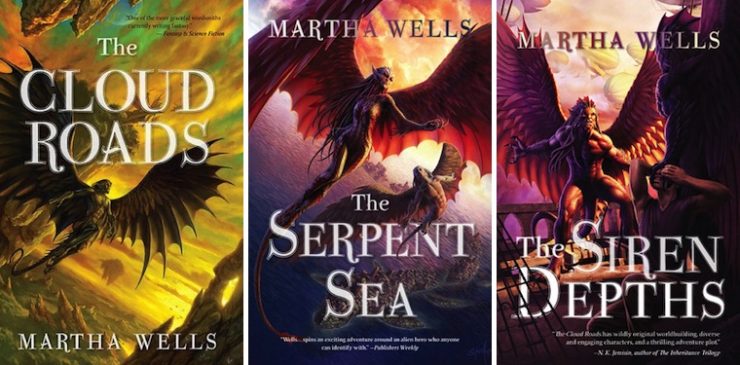Martha Wells’ Three Worlds are a bravura achievement. They’re a single planet populated by literally hundreds of different species, many of them sentient, and most more or less able to coexist—with a few notable exceptions. The “worlds” themselves are the three realms which people and animals inhabit: sea, land, air. Various species move back and forth by various means, but it’s generally clear which of the realms they primarily belong to.
The central species, the one around which Wells’ novels and stories revolve, is the Raksura. Originally they were two species, a winged predator and an arboreal omnivore; by magic and genetic engineering, they combined into one. By the time of the books, they’re thoroughly amalgamated into colonies or courts, ruled by queens.
They are also, because why not, shapeshifters. All of them have two forms. One is more or less human as we would understand it; this is called the groundling form. The other is scaled and clawed, either wingless Arbora or winged Aeriat. Only the queens have no humanlike form: When they shift out of winged form, they become Arbora.
Arbora are fertile with each other and with queens or the fertile winged males, the consorts. Aeriat, except for the consorts, are sterile; they’re the warriors, the defenders of the colony. They eat and fly and fight and sleep. They’re not, in general, intellectuals, as opposed to Arbora, who are obsessively and exuberantly creative. Arbora do most of the practical work, the teaching, the childrearing, the farming and building and smithing and weaving and all the rest of the crafts and arts.
The queens are huge and powerful, irascible and often belligerent. Senior Arbora, notably the mentors who are wizards of a sort, balance them, advise them, and rein them in. The reigning queens are Powers in their own right, backed by the whole force of their combined courts. They bear a fair resemblance to Anne McCaffrey’s queen dragons, with much the same sense of responsibility to their colony and their species.
Consorts are a little like bronzes, and warriors are quite a bit like green dragons. It’s a nice sense of familiarity, even as the Raksura expand the possibilities tremendously. The Arbora bring their manifold talents to the mix; the Aeriat can present as either dragons or humans—and can fight in either form, though they’re strongest in winged form.
Buy the Book


The Cloud Roads
They’re like lions, too, in that females rule; and especially like bees, with queens and workers and mostly idle, heavily protected drones. The combination of fictional and real-world species works. It makes sense in its context, and it’s supported by wonderful writing, strong plotting, and characters as real as words can make them. Moon the misfit consort; Jade the earnest young queen; Chime the mentor turned warrior and struggling to adapt to the transformation; Pearl the old and bitter queen; the mighty Malachite, scarred and broken and all the stronger for it—and that’s just a few of the many people who fill these books with life and wonder.
There is nothing else quite like them, and nothing like their world. It teems with species both more and less sentient, and all those of approximately equal intelligence are described as men and women, though they might have fur or feathers or scales, gills or fins or wings, green skin or blue or grey or any other color of the spectrum. All of them are capable of communicating with other species in some fashion; many live together in towns or cities, sharing space and resources, even while they retain their own individual languages and cultures.
All of them, whatever they look like, however they live their lives, are people. None of them looks like our kind of human—except, ironically, the groundling forms of Raksura. And yet every one is a fully realized person.
That’s the greatest achievement of these books. To show us an extravagant variety of shapes and forms, but to write them all with the same deep, dare I say it, humanity.
Judith Tarr is a lifelong horse person. She supports her habit by writing works of fantasy and science fiction as well as historical novels, many of which have been published as ebooks. She’s written a primer for writers who want to write about horses: Writing Horses: The Fine Art of Getting It Right. She lives near Tucson, Arizona with a herd of Lipizzans, a clowder of cats, and a blue-eyed dog.














